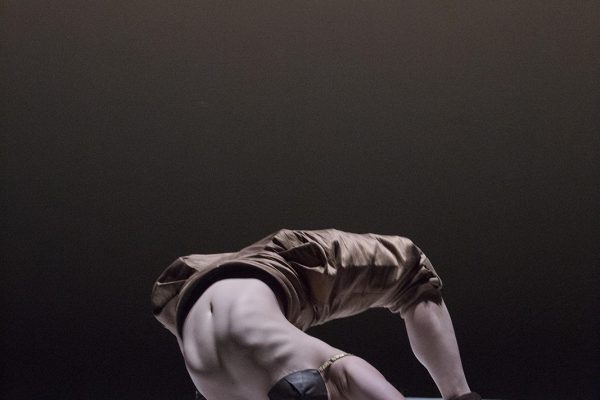Story ballets have been around a long time, and at their best they combine compelling characters with just the right amount of plot – not so much that you need to memorize a libretto beforehand, but enough to provide a clear arc of action. That’s pretty much what Crystal Pite treats us to in the short story collection titled The You Show, given its Canadian premiere at the Vancouver East Cultural Centre following a November 2010 run in Germany.
The four tales are told with some text, but primarily through the restless, virtuosic and emphatic flow of movement for which Pite is known. Make that “well known” — the west coast Canadian is now a name to be reckoned with. Alastair Macaulay in the “New York Times” ended his 2008 review of Cedar Lake Contemporary Ballet, who danced Pite’s “Ten Duets on a Theme of Rescue”, by saying he wants to see more of her work. Wendy Perron, the editor of “Dance Magazine” in the United States, recently listed her as a choreographer of note along with William Forsythe (in whose company Pite danced for several years), Christopher Wheeldon, Alexei Ratmansky, Jorma Elo and Wayne McGregor. Pite’s popularity is also evidenced by the fact that her company, Kidd Pivot, is currently based both in Vancouver and in Frankfurt, where a generous residency arrangement is acknowledged by the addition of Frankfurt RM to the group’s name.
The You Show — three duets and one ensemble piece ranging from twelve to forty minutes — is a modest production, with no multimedia elements or even a set. All four pieces do have meticulously rehearsed movement, stark lighting by Robert Sondergaard, an atmospheric soundtrack by longtime collaborator Owen Belton and costume design by Linda Chow, who puts everyone in beautifully tailored black suits that seem both eighteenth- and twenty-first century at the same time.
“A Picture of You Falling” opened. It’s the one remount, having premiered at the Canada Dance Festival in 2008. This moody duet for Peter Chu and guest artist Anne Plamondon is like a detective story, with a female voice-over dropping clues about a previous encounter. Some clues are obscure, and describe the on-stage movement: “This is you reaching back…” or “This is a picture of you falling…” Others establish a concrete setting, describing a particular room — it has a bed, a window — feeding us with images that fill in the square of light on the stage floor.
This lovers’ duet is full of exits and entrances; pushing and pulling; and long, slow falls. There are embraces and close pas de deux: when Chu lifts Plamondon, her light, thoroughbred body (lots of ballet training and, as co-director and performer with Rubberbandance, contemporary influences) passes over and around his body like a stream of water, seeping into his pores. The situation in “A Picture of You Falling” is enigmatic but not completely mysterious: we never learn exactly who these two people are, or why they were once together and are now apart, but their emotional connections and disconnections seem familiar.
“The Other You”, which followed, was seriously mysterious: this is the kind of spooky tale that people like to tell on a dark and stormy night. The stage is bare, dimly lit; the sound of a barking dog and ocean waves in the distance, as well as a high wind, evoke a deserted, lonely setting — a cliff top, perhaps. Eric Beauchesne and Jiri Pokorny are the look-alike characters: twins, or two sides of the same person. In a series of intense encounters, they establish a psychical closeness that gives them physical power over each other. One man moves a hand; the other man’s leg lifts. One swings his arm out; the other flinches as if he’s been struck. One crawls on his hands and knees toward the other, who snarls like a dog. By the end, when Beethoven’s “Moonlight Sonata” sets an eerie romantic tone, and the two stand below a high spot that could have been a moon, I had goose bumps and thought of werewolves.
After intermission, “Das Glashaus”, despite its brevity — a mere twelve minutes – seemed to drag. Yannick Matthon and Cindy Salgado were as physically precise as the earlier duos, and there was a striking soundscape of breaking glass, but the dramatic impulse — a sense of who the dancers are and the engaging dramatic arc — was less sure. If I had been reading a book, I would have skimmed this one.
For different reasons, I might also have read the final piece, “A Picture of You Flying”, quickly: this adventure comic about lovers and superheroes is fun and easy to digest. Jermaine Maurice Spivey opens with a monologue about his “identity crisis”: how he tries to blend in, his difficulties with relationships, the fact that “tights suck” and “you never get used to them, but it’s tradition.” He could be talking about life as a dancer … until he puts on a red cape. “It’s not about the glory,” he insists — and he could still be talking about life in dance, except that now the whole company comes on (the earlier couples, plus Sandra Marin Garcia and apprentice Rena Narumi), striking action poses and beginning a crazy comic-book fantasy about superheroes battling evildoers.
What a stylish cast of characters! Those dreamy suits, the sleek bodies … but then they lunge and grimace and punch and kick with mega-good guy/bad guy energy. Garcia alternates between being the love interest and the baddest of the baddies as the epic music soars and world destruction looms. Thank God for Spivey, who stands upstage, waving his cape behind him as if to make it look like he’s flying.
Over the years, Pite has honed and refined her vocabulary. At this stage, the forty-year-old mother of one (her son, Niko, is a few months old) creates work that is uniquely her own: there is a warm heart beating underneath the edgy aesthetic, and a will not only to astonish but also to communicate. As Pite writes about The You Show in her program note: “I invite you … to see yourself falling and flying as the hero of your own existence.”
Tagged: Ballet, Contemporary, Performance, BC





